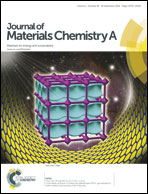Electrospun nanofibers with a core–shell structure of silicon nanoparticles and carbon nanotubes in carbon for use as lithium-ion battery anodes†
Abstract
Core–shell structured nanofibers, consisting of silicon nanoparticles and carbon nanotubes encased in carbon (SCNFs), were fabricated for use as an anode material in lithium-ion batteries (LIBs). This entailed first electrospinning of precursor solutions containing a blend of silicon nanoparticles (SiNPs), carbon nanotubes (CNTs), and polyvinylpyrrolidone (PVP) for the core, and polyacrylonitrile (PAN) for the shell. The final SCNF structure was obtained by carbonization at 1000 °C for 1 h under nitrogen; the core–shell structure achieved with varying carbon contents was determined by scanning electron microscopy, transmission electron microscopy, and water contact angle measurements. An evaluation of the electrochemical performance of SCNF-based anodes in LIBs found that a SCNF electrode with 1 wt% CNTs has an initial delithiation capacity as high as 1500 mA h g−1 at C/10 rate and a retained capability of 50% at high rates (10C). Following the 100th cycle at 1C, a capacity of 1000 mA h g−1 and coulombic efficiency of 99% were achieved, the former representing 74.1% of the original capacity (1350 mA h g−1). Thus, not only does the robust carbon shell of SCNFs minimize the effect of volume expansion in the SiNPs, but the CNTs in the core also provide a greater number of conductive pathways, both between SiNPs and to the carbon shell, which assist electrochemical reactions.


 Please wait while we load your content...
Please wait while we load your content...